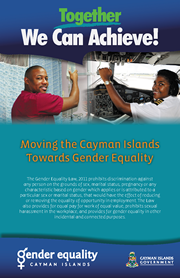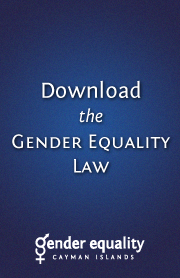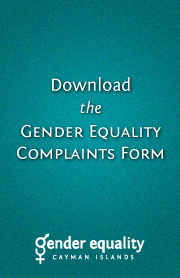Gender equality refers to the right of women and men to have the same opportunities for the achievement of important goals in society such as education, employment and income and to contribute to political, social, and cultural development at all levels. Promising equal pay, equal opportunity, as well as freedom from discrimination and harassment in the workplace to all persons, whether they are men, women, married, single or pregnant, gender equality in essence promotes the equitable and respectable advancement of men and women together. As such it is considered a highly desirable objective for organizations and governments around the world that are seeking to establish and consolidate socio-economic structures that will facilitate development.
Many think of the Cayman Islands as a modern country that affords equal opportunities to men and women. On the surface that is true, but when we dig deeper and look at the statistics that are available to us, it becomes obvious that men and women in the Cayman Islands are not afforded equal opportunities, nor are they on a level playing-field when it comes to income and other areas.
Situation in Cayman
The Labour Force Survey (2009), by the Economics and Statistics Office (ESO), shows that males make up 50.5% of the labour force and females 49.5%, which is near equal participation. At the same time this equality does not translate to income. Females make up the majority of the two lowest salary brackets in this survey. Eighty three point three per cent (83.3%) of persons making less than $800 per month were women and sixty three point five per cent (63.5%) of those making less than $1,600 a month were also women. Being confined to the poorest of the poor is extremely challenging especially for women who often times are the sole bread winner of their families and do not receive any or adequate financial assistance from the father of their children.
On the opposite end of the spectrum, men comprised sixty five point five per cent (65.5%) of the persons making $7,200 or more a month, whereas women only represented thirty four point five per cent (34.5%) of this highest level of income earnings. It is however notable and encouraging that women and men are closer to being equally represented in the middle income brackets in this survey.
This suggests that not only are women under-represented at the highest salary brackets in our country, but they are also, more often than not, paid less than men for doing the exact same work. Information obtained from the Occupational Wage Survey (2005) that was conducted by the Department of Employment Relations seemingly depicts high levels of gender discrimination when comparing the monthly salaries of men and women performing the same occupation. Of 87 occupations in which salary comparisons could be made between males and females holding the same positions, there was only one occupation that paid an equal monthly salary to males and females performing the same work. In 60 of the remaining occupations, men reported a higher monthly average salary than women, while women reported a higher average salary than men performing the same work in 26 occupations.
Business Case for Gender Equality
“In today's 21st century knowledge economy, talent is the most important natural resource a nation possesses. Continuing to nurture the most worthy, diverse talent — including women — and giving talented people the chance to advance to decision-making levels plays a critical role to staying competitive in the global economy.” http://gregpellegrino.wordpress.com/2010/03/25/gendernations-the-growing-role-of-women-in-government/
Deloitte has conducted international research that showed the top 500 multi-national firms, which had at least three women on their boards, saw a 16.7% return on equity; average companies saw just 11.5%. The greater the number of women the greater the difference; those with the greatest number of women in on their boards had 53% greater return on equity than those with the fewest. Thus when women are represented in increased numbers at the higher levels of decision making, not only is it a step towards gender equality but it is also a positive move that companies should embrace because of the potential financial benefits.
This is also true of national economies. As an example, one of the five drivers that is considered essential to Cayman's future success, and outlined in the Future of Cayman Agreement between Government and the Chamber of Commerce, is to “Enhance the Quality of Life” for our people. One way to do that the Chamber notes is to strive towards “Enhancing and embracing diversity.” Although the Cayman Islands has a proud history of prominent women in the workplace, this new legislation will encourage gender diversity, by giving men and women equal opportunities in all but the few jobs that legally qualify for exceptions.
It is often said that the Cayman Islands must compete with the wider world, for business and its workforce. The Cayman Islands Government believes that if the Cayman Islands are seen to be actively striving towards gender equality, this will assist in enhancing our image as an attractive place to work and do business.
Real World Examples of Discrimination as It Relates to the Gender Equality Law
- Male and female employees holding the same position receive different pay, even when other factors such as experience, education level, etc. are similar.
- Asking married employees to leave their ring at home.
- Asking any woman to resign on becoming pregnant or not hiring a woman because she is pregnant.
- Asking female applicants about future pregnancy possibilities during a job interview.
- Denying pregnant school girls access to an education that is equal to their peers.
- Asking gender stereotyped questions during an interview. Examples include: “Have you ever cried at work?” and, “Are you sure you can supervise men?”
- Inappropriate and unwanted conduct of a sexual nature in the workplace that has the effect of creating a hostile working environment, violating the dignity of the employee or intimidating, degrading, humiliating, or offending the employee.
- Making sexual comments or commenting on physical appearance as a part of the hiring process.
- Making unwanted sexual advances at any time during recruitment or employment.
- Passing up men or women for promotion because of their marital status.
- Restricting one sex access to certain work meetings that are held away from the office, e.g. the golf course or the rugby club.
- A professional partnership refuses or deliberately omits offering a position to a person based on the grounds of sex, pregnancy, marital status or gender characteristics.
- A vocational training body refuses to provide access to cosmetology training to a male.
- An employment agency refuses to place a qualified woman as an employee at a male dominated construction site, when a genuine occupational qualification for an exemption does not exist.
- A qualifying body- for example the electrical qualifying board- fails to confer qualifications upon a woman, simply on that basis.
- Charging women more than men or vice versa for the same services.
- A sporting facility doesn't allow or gives different terms of use to female teams.



